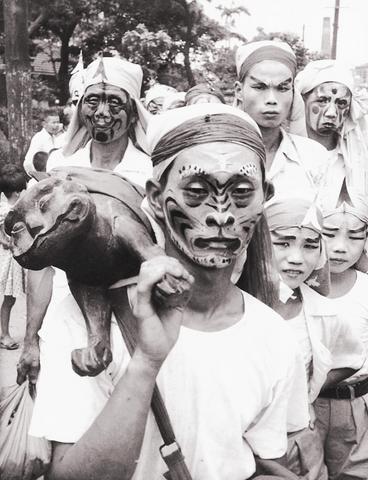"I am not highly educated. I just use my camera to observe people and things. It doesn't have to appear `artistic,'" was Chang Tsai's (張
The 71 works in Classic Chang Tsai -- the Unreleased Photos, (遺

PHOTO COURTESY OF TIVAC
A series of photos of egrets taken in Taipei's Guandu at sunset are the most beautiful works in the exhibition. According to Chang Tsai's son, the two set out from their home before every sunset and rode to the water front with their Leica and several makeshift lenses, which were unsuited for wildlife photography, and spent a good few hours patiently waiting for their subjects.
Chang always captured them in their most serene and confident posture against a background of amazingly geometrical tree branches. These small-format prints have acquired a sense of mystique over time, as flood water and moisture made white marks on the paper that look like passing clouds or reflections on rivers.
Tao Aborigines on Orchid Island are the subjects of another enduring series taken in the 1940s. At a time well before the commercialization of their pristine environment, Tao men and women let Chang record their daily life and take their portraits, sometimes in exchange for just a few Taiwan-made cigarettes. They look diligent yet contented with their lifestyle. A photo of a lone Tao man carrying a small pot of drinking water to his shed implies the Tao's easy-going attitude to life that is worlds away from the current tourism-driven islands.
Chang was one of the first generation of Taiwanese photographers with an academic background. At 18, Chang went to Tokyo to study photo portraiture. Five years later, he opened his photo studio in Taipei. In 1942, Chang and his newly-formed family went to do business in Shanghai. Chang's photgraphy career did not really take off until he returned to Taipei with his first solo exhibition in what is now Zhongshan Hall in Taipei. Since then, Chang has organized exhibitions and published photography journals in Taiwan and exhibited abroad.
His series of portraits of Tao Aborigines near Jade Mountain remains the highest-acclaimed. One of Chang's favorites from the series -- the imperturbable and dignified face of a Tao prince -- is also on show.
Classic Chang Tsai -- the Unreleased Photo Works, runs through Feb. 18 at Taiwan International Visual Arts Center, 29, Ln 45, Liaoning St, Taipei. (台

This month the government ordered a one-year block of Xiaohongshu (小紅書) or Rednote, a Chinese social media platform with more than 3 million users in Taiwan. The government pointed to widespread fraud activity on the platform, along with cybersecurity failures. Officials said that they had reached out to the company and asked it to change. However, they received no response. The pro-China parties, the Chinese Nationalist Party (KMT) and Taiwan People’s Party (TPP), immediately swung into action, denouncing the ban as an attack on free speech. This “free speech” claim was then echoed by the People’s Republic of China (PRC),

Exceptions to the rule are sometimes revealing. For a brief few years, there was an emerging ideological split between the Democratic Progressive Party (DPP) and Chinese Nationalist Party (KMT) that appeared to be pushing the DPP in a direction that would be considered more liberal, and the KMT more conservative. In the previous column, “The KMT-DPP’s bureaucrat-led developmental state” (Dec. 11, page 12), we examined how Taiwan’s democratic system developed, and how both the two main parties largely accepted a similar consensus on how Taiwan should be run domestically and did not split along the left-right lines more familiar in

Specialty sandwiches loaded with the contents of an entire charcuterie board, overflowing with sauces, creams and all manner of creative add-ons, is perhaps one of the biggest global food trends of this year. From London to New York, lines form down the block for mortadella, burrata, pistachio and more stuffed between slices of fresh sourdough, rye or focaccia. To try the trend in Taipei, Munchies Mafia is for sure the spot — could this be the best sandwich in town? Carlos from Spain and Sergio from Mexico opened this spot just seven months ago. The two met working in the

Many people in Taiwan first learned about universal basic income (UBI) — the idea that the government should provide regular, no-strings-attached payments to each citizen — in 2019. While seeking the Democratic nomination for the 2020 US presidential election, Andrew Yang, a politician of Taiwanese descent, said that, if elected, he’d institute a UBI of US$1,000 per month to “get the economic boot off of people’s throats, allowing them to lift their heads up, breathe, and get excited for the future.” His campaign petered out, but the concept of UBI hasn’t gone away. Throughout the industrialized world, there are fears that